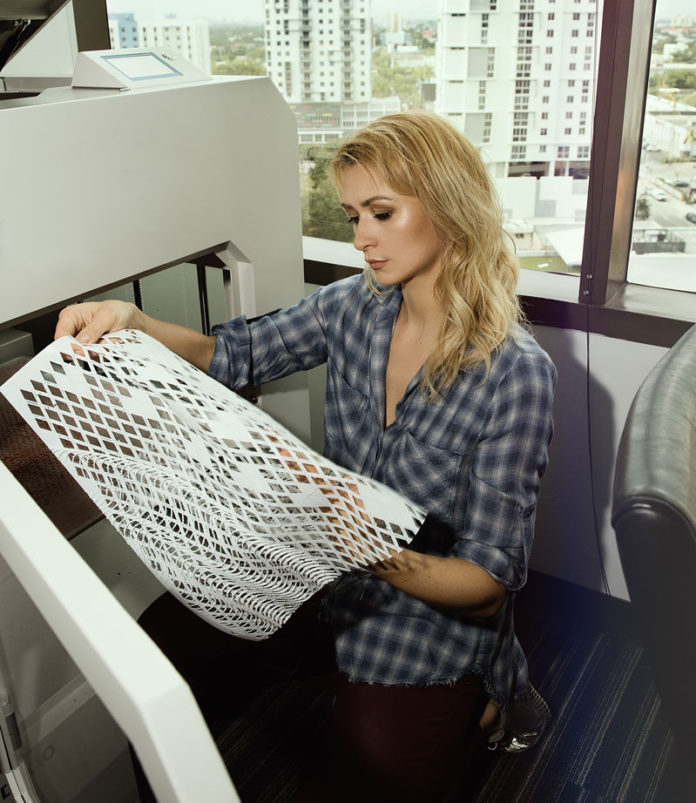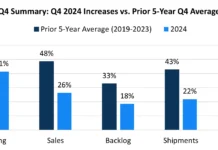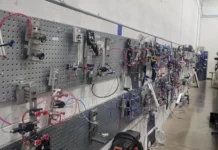Edited by Nancy Cates, contributing writer
Plastics Business
Managing Editor’s note: Innovation is the name of the game, and Julia Daviy is at the forefront of the 3D-printed fashion industry. Although I doubt if many Plastics Business readers are using their 3D printers to whip up a new blazer on the weekend, it’s important to keep an eye on the possibilities – and Daviy is watching an $804 billion global textiles industry that lives and dies by the bringing the latest trends to market quickly.
Imagine a sustainable, low-waste, highly personalized method of designing, fitting and producing clothing and accessories. How? How about with a 3D printer?
That’s the concept and goal being pursued by Julia Daviy in her Miami, Florida, 3D Printed Clothing Lab. Daviy, who presented a 3D-printed collection at New York Fashion Week last fall, is committed to reducing environmental impact and sparking creativity with her revolutionary approach to fashion design.
Daviy said she began out of the desire to create a sustainable method of clothing production and to implement her vision of clothing with new levels of functionality. “I had a lot of curiosity and was continuously asking myself ‘what if’ questions,” she said. “I permitted myself to experiment, make mistakes and not have any specific business in mind.”
Daviy, whose educational background includes degrees in environmental science and international economics, previously operated a successful international business and had experience working as a corporate executive in the clean technology industry. That work led to invitations to judge innovation contests and increased curiosity about modern approaches to invention.
“I took an online course from the University of Maryland on the creation of innovations,” she said. “Long story short: My journey in fashion started from launching an activewear line made from organic fabrics and innovative ‘eco-friendly’ dyeing techniques. At that stage, my main idea was to create clothing that followed the highest standards of environmental impact that – at the same time – did not sacrifice design. From a business point of view, I probably should have kept that project and continued to develop it. But after investigating the situation in each stage of the clothing-making chain, I discovered that this method of production is a dead end. We need technology and new approaches to react adequately to challenges in traditional clothing manufacturing. Changing fabrics and dyeing techniques is just not enough.”
Daviy explained that the first experiments in 3D-printed shapes and hard materials developed from 2010 to 2014. “I found that 3D printing in the clothing industry is developing slowly because it needs a combination of knowledge – in traditional clothing design, in 3D modeling and in 3D printing. At that time, we did not have any specialists – probably in the entire world – who had technical knowledge in all three areas. Three years ago, I decided to learn all of these and dove into learning and experimentation.”
Design has taken on a new dimension for Daviy. “Current day design in the clothing industry has an absolutely different meaning than it did in the past. It is about the creation of new products – the clothing that will be able to solve problems. It’s also about designing a new, smart and ethical method of production.” Daviy said the traditional methods of fashion industry production involve hard work for little pay. In addition, she said, the methods include unethical treatment of animals, wasted time and resources (about one-third of all fabric made is discarded after patterns are cut), and result in clothing that doesn’t meet current needs.
Daviy said feedback from other designers, potential clients and others has run the gamut. “I have a lot of positive, inspiring (and inspired) comments,” she revealed. “Many fashion designers around the world are writing me. Some want to obtain knowledge, some like my approach of using 3D printing for achieving sustainable clothing production, some mention that my works inspired them with their own experimentation, design and work in fashion technology. Many requests are from fashion students and Z-Generation young people. I find this kind of feedback and interest to be very precious.
“Others are very far away from 3D printing and cannot even realize what it means to ‘3D-print’ clothing. Recently, when I visited a textile expo, I realized that even people from the clothing industry rarely understand that what we do is actually possible.”
Daviy’s process of creating and designing an article of clothing is interactive and, at this stage of development, is considered a luxury segment. “We created a software platform that permits the consumer to feel like a designer. Now we are at the stage of testing it. For example, you may customize your one-of-akind 3D-printed skirt and get it made to order. At this first test stage, you can customize length, style, pattern, add pockets and regulate the height of a waist wrap. Launching sales of 3D-printed, made-to-order and digitally customizable garments is an important step for me and my team.”
Her work has attracted potential customers who are interested in specific 3D-printed clothes – so many that the lab can’t satisfy all the requests. The lab is involved with research and development projects and also is exploring possibilities with business-to-business clients.
During her presentation, Daviy noted that the current global leather market is worth $43 billion (US), with 3.7 billion animals killed for leather, according to Common Objective data. “The leather goods industry is a potential market that can be completely rethought and used for 3D printing companies’ expansion,” she asserted. “Moreover, it is on time. Some 75% of consumers representing Generation Z will choose a product to support an ethical mission that does not create harm. I would say that we underestimate the marketing potential of sustainability itself. It is the fastest growing trend in fashion.”
Daviy said ethics and eliminating fur and leather for clothing and accessories is another strong trend. “3D printing is able to bring an absolutely new level of design work – shapes, patterns, colors and textures that are impossible to make in the leather industry. Traditional leather, in comparison, is a boring material. 3D-printed accessories and clothing also means customization, which is impossible in the traditional way of production.”
In looking at the global textile industry – worth $804 billion, with 5% growth anticipated this year – Daviy cited other advantages of 3D-printed clothing and accessories:
- Smart production, with a transparent and short production chain
- Ease of management
- Opportunities to create smart clothing and accessories by incorporating wearable electronics
- High potential for recycling
Obstacles remain in creating 3D clothing, and Daviy and a partner are patenting some potential solutions.
“Everyone wants faster 3D printing,” she said, “and I’m not an exception. I dream about 3D printers that are able to create high-elastic durable clothes 3D-printed as one single piece without the need for long post-processing and trimming. A much bigger 3D printing volume is essential. I would change the internal design of the STL 3D printer completely.”
Her description of the perfect 3D SLA printer? A low 3D printer with a print area of 1 square meter, with a transparent light bath, on the bottom of which the structure is formed using technology similar to the continuous liquid interface production (CLIP).
Considering the challenges that continue to slow progress in the 3D-printed fashion industry, Daviy noted issues with decision-making, implementation and acceptance of change as factors.
“Innovation and 3D-printing challenges need absolutely new kinds of people,” she said.
Challenges don’t stop progress, though. In her presentation, Daviy noted that files for 3D-printed shoes, among other items, are available online at thingiverse.com. And, on the mass production scale, the technology has developed enough to have 3D-printed wearable products successfully marketed: “For example,” Daviy said, “Adidas did not focus on negatives. It simply produced 100,000 sneakers with 3D-printed midsoles last year.”





